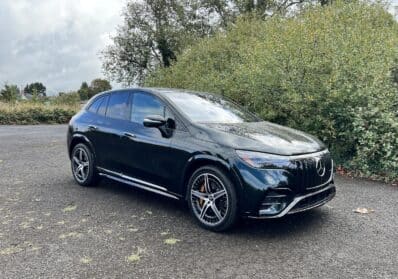For the first couple moments I feel almost blind as I step out of the blazing Florida sun into the dark, dank garage beneath the Amelia Island Ritz-Carlton hotel. As my eyes slowly begin to adjust I notice a brightly lit light bar against the back wall. Next to it stands Derek Jenkins.
In the startup world, Jenkins wears plenty of different hats, but his primary role is chief designer for the upstart automaker Lucid Motors. Over the years, he’s worked for a number of more familiar brands, including Audi and Mazda. But Lucid has provided Jenkins a unique opportunity to help create not just a new car but an entirely new car company.

The automaker started showing a prototype four years ago and formally debuted its first product, the Lucid Air, during a virtual presentation last September. This is my first chance to check out the big sedan in person. And Jenkins has kindly offered to give me a ride during a break from the annual Amelia Island Concours where the Air is enjoying its first public showing.
A different approach
Coming to market first with a sedan, rather than an SUV, has been a bit controversial. This is an era overwhelmingly dominated by utility vehicles. But both Jenkins and his boss, Lucid CEO and Chief Engineer Peter Rawlinson, are convinced this was the right decision. While the four-door Air might not generate as much demand, it will serve as the halo car that, Rawlinson told me during a recent interview, sets the visual tone of the new brand.
And Lucid wants to “resolve” and “redefine” what a sedan can look like, Jenkins says, as we look over the pearly white Air. Besides, he adds, “a sedan is a great format to show off the range and performance” that Lucid’s all-electric drive technology is capable of.

The all-electric sedan is roughly the size of Tesla’s big Model S and will directly challenge that now well-established competitor. Like the Model S, the Lucid Air is designed to slice through the wind like a knife. The door handles are flush with the body, for example, popping out only when you need to get inside. Good aerodynamics are key to maximizing range and performance. Both have gone with minimalist grilles since the only real need for airflow with a battery-car is below, cooling its battery pack and motors.
The Air has a cleaner, more compelling face, however, with a subtle light bar — now de rigueur on a modern EV — atop two strips of multi-LED headlights. The hood is smooth, with only subtle creases leading up to the steeply raked windshield. One of the car’s more distinctive details is the way the windshield flows into the roof, extending all the way back to the B-pillars behind the front seats. The upper area features a virtually transparent metallic coating that will shortly be put to good use, reducing the heat load once we head out into the Florida sun.
With a coke bottle curve to its silhouette and a wraparound taillight display, the design of the Lucid Air is disarmingly simple yet elegant. It speaks of luxury, but also hints of the power packed underneath in the sedan’s skateboard like platform.
Performance and comfort

There will be a number of different versions of the Lucid Air but, when the first production model comes to market in the months ahead the flagship Dream Edition will set the halo around the brand. It will be equipped with a twin-motor drivetrain producing a combined 1,080 horsepower — enough to launch the sedan from 0 to 60 in about 2.5 seconds. Officially, it will run the quarter-mile in just 9.9 seconds, though Rawlinson told TheDetroitBureau.com last years that he’s personally managed to beat that figure. Top speed is rated at 168 mph.
It’s finally time to check out the cabin and, even in the world of EVs, the roominess comes as quite a surprise. Pushing the front shotgun seat back to accommodate my 6’2” frame the rear boasts the sort of legroom you’d expect from the likes of a Bentley Flying Spur.
It helped, Jenkins explains, that Lucid developed virtually everything from scratch, rather than relying on traditional automotive vendors. That includes an uncannily miniaturized drivetrain and the climate system that normally takes up a massive amount of space on the passenger side of the firewall. This approach allowed the product development team to push the instrument panel forward, well into what would normally be an engine compartment. (They still managed to maintain a sizable “frunk” under the hood, as well.)
The interior is elegant in an intentionally minimalist way. There are a handful of conventional controls for climate but, as has become more the norm than exception these days, most operations are handled by touchscreen. There are three screens in the Air, including the large digital gauge cluster behind the steering wheel and, to its right, the first of two displays handling infotainment duties. With a simple swipe of the fingers, various features can be moved back and forth between the two touchscreens.

While I don’t have the time to extensively test out the system it becomes clear that Lucid’s user experience is aimed at simplicity. There are plenty of different features built into the infotainment system but the driving design goal was to minimize the effort a motorist would need to find what’s needed.
What a ride
Strapping in, Jenkins shifts the Air into gear and maneuvers out of the parking lot, through the Concours crowds and onto Amelia Island Parkway. This particular prototype is equipped with the optional 21-inch wheels and the design chief apologizes for the slight roughness they add compared to the standard 19-inchers. He also frets about the nearly imperceptible wind noise around the driver’s window, promising that and some minor fit-and-finish issues will be resolved by the time production begins.
There’s an elegance to the ride experience as we push further away from the Concours and onto some wide open Florida roads where Jenkins finally can demonstrate the most compelling part of the Lucid Air Dream Edition — its all-electric drivetrain.
Electric motors reach maximum tire-spinning torque the instant they’re turned on. I’ve experienced what that means in a number of BEVs in the last several years, including the Chevrolet Bolt, Ford Mustang Mach-E and, especially, the Tesla Model S with Ludicrous Mode. That said, I’m still unprepared for what happens when my host hammers the throttle.

With the initial launch I sink deep into the sedan’s well-padded seats. But where most electrics start to level off around 30 to 40 mph, the Air just keeps pulling. I start to pull that narrowing of peripheral vision you get in a fast car on the dragstrip. At 90 the Air feels like it’s still accelerating, rocket-like. I have no doubt it would have continued to do so once in triple digits.
It feels effortless and confoundingly smooth. There’s the athleticism of a triathlete with the poise of a ballerina as Jenkins repeats the exercise several more times.
Future expectations
I’d love to feel what it’s like to wind the Air through some corners and elevation changes. Those are few and far between in the northeast corner of Florida, so that’s something that will give me a good reason to press Lucid for a second ride later — and, I hope, an opportunity to finally slip behind the steering wheel myself.
I’ll also look forward to seeing just how well the Air delivers on the other significant promises made by Rawlinson, Jenkins and the Lucid team. Depending upon the model, Air is expected to get as much as 517 miles range when the numbers are finalized by the EPA — the Dream Edition targeted at around 503. If these numbers hold it would make Lucid the first automaker to break the 500-mile barrier and come in substantially above the longest-range version of the Tesla Model S.
On top of that, the Air’s 900-volt electrical architecture will, Lucid claims, allow the addition of another 300 miles in just 20 minutes when plugged into a 350-kilowatt DC quick charger.
Those are things I can only hope to confirm in the months ahead. But if my first experience in the Lucid Air Dream Edition is any indication, it really could be a dream come true.











